During compensatory shock - Study guides, Class notes & Summaries
Looking for the best study guides, study notes and summaries about During compensatory shock? On this page you'll find 2374 study documents about During compensatory shock.
Page 3 out of 2.374 results
Sort by
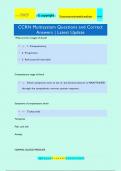
-
CCRN Multisystem Questions and Correct Answers | Latest Update
- Exam (elaborations) • 16 pages • 2024
- Available in package deal
-
- $10.49
- + learn more
What are the 3 stages of shock? -:- 1. Compensatory 2. Progressive 3. Refractory/Irreversible Compensatory stage of shock -:- Shock symptoms start to set in, but blood pressure is MAINTAINED through the sympathetic nervous system response Symptoms of compensatory shock -:- Tachycardia Tachypnea Pale, cool skin Anxiety NORMAL BLOOD PRESSURE 2 | P a g e | G r a d e A + | 2 0 2 4 / 2 0 2 5 Excel! 2 0 2 4 /2025 | © copyright | This work may not be copied for profit gain Ho...
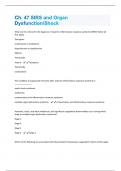
-
Ch. 47 SIRS and Organ Dysfunction/Shock Questions With 100% Correct Answers.
- Exam (elaborations) • 24 pages • 2024
-
- $8.39
- + learn more
What are the criteria for the diagnosis of systemic inflammatory response syndrome (SIRS)? Select all that apply. Tachypnea Leukocytosis or leukopenia Hyperthermia or hypothermia Oliguria Tachycardia Submit - Tachypnea Tachycardia Leukocytosis The condition of suppressed immunity after systemic inflammatory response syndrome is _______________. septic shock syndrome septicemia compensatory anti-inflammatory response syndrome multiple organ dysfunction syndrome - compensatory anti-...
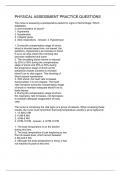
-
Physical Assessment Practice Questions
- Exam (elaborations) • 22 pages • 2023
-
- $12.49
- + learn more
The nurse is assessing a postoperative patient for signs of hemorrhage. Which adaptation is most indicative of shock? 1. Hyperemia 2. Hypotension 3. Irregular pulse 4. Slow respirations - Answer- 2. Hypotension 1. During the compensatory stage of shock, blood is shunted away from, not toward, the periphery. Hyperemia is an increase in blood fl ow to an area where the overlying skin becomes reddened and warm. 2. The circulating blood volume is reduced by 25% to 35% during the compen...
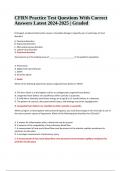
-
CFRN Practice Test Questions With 100% Correct Answers Latest 2024-2025 | Graded A+.
- Exam (elaborations) • 49 pages • 2024
-
- $12.99
- + learn more
CFRN Practice Test Questions With 100% Correct Answers Latest | Graded A+. Head injuries are the leading cause of ______________________ in the pediatric population. A. Pneumonia B. Degenerate spinal disease C. Death D. All of the above C. Death Which of the following statements about congenital heart defects is TRUE? A. The term infant is at the highest risk for an undiagnosed congenital heart defect. B. Congenital heart defects are classified as either cyanotic or acyanotic. C. A chi...
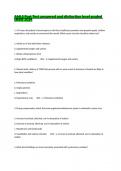
-
AMLS Post Test answered and distinction level graded latest 2024
- Exam (elaborations) • 15 pages • 2024
- Available in package deal
-
- $11.49
- + learn more
. A 45-year-old patient is found supine on the floor. Healthcare providers note pinpoint pupils, shallow respirations, and vomitus in and around the mouth. What course of action should be taken next? a. Initiate an IV and administer naloxone b. Supplemental oxygen and suction c. Obtain a blood glucose level d. Begin BVM ventilations ANS: - b. Supplemental oxygen and suction 2. Patients with a history of COPD that present with an acute onset of shortness of breath are likely to hav...
![NURS 223: Exam 2 [Chapters 18, 35-40, 48-49] Well-Enlightened with 100% correct answers.](/docpics/5385457/664c714d1e824_5385457_121_171.jpeg)
-
NURS 223: Exam 2 [Chapters 18, 35-40, 48-49] Well-Enlightened with 100% correct answers.
- Exam (elaborations) • 67 pages • 2024
- Available in package deal
-
- $17.99
- + learn more
The nurse and nursing student are assessing a client experiencing shock. The nurse teaches the student that which of these findings reflects compensatory sympathetic stimulation in a shock state? a) decrease in the serum creatinine b) overgrowth of the glomerular basement membrane c) increase in thyroid hormone production d) decreased urine output correct answers d) decreased urine output During periods of strong sympathetic stimulation, such as shock, constriction of the afferent ar...
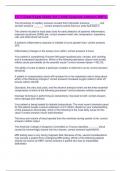
-
CCT Final Exam Study Set || with Accurate Answers 100%.
- Exam (elaborations) • 23 pages • 2024
-
Available in package deal
-
- $12.99
- + learn more
The physiology of capillary pressure reveals that hydrostatic pressure _______ and osmotic pressure _______. correct answers pushes fluid out, pulls fluid back in The criteria included in most basic tools for early detection of systemic inflammatory response syndrome (SIRS) are: correct answers heart rate, temperature, respiratory rate, and white blood cell count. A systemic inflammatory response is initiated in burns greater than: correct answers 25% Inflammatory changes in the airway ...
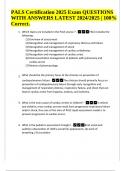
-
PALS Certification 2025 Exam QUESTIONS WITH ANSWERS LATEST 2024/2025 (100% Correct)
- Exam (elaborations) • 29 pages • 2024
- Available in package deal
-
- $17.99
- + learn more
PALS Certification 2025 Exam QUESTIONS WITH ANSWERS LATEST 2024/2025 (100% Correct) What should be the primary focus of the clinician on prevention of cardiopulmonary failure - The clinician should primarily focus on prevention of cardiopulmonary failure through early recognition and management of respiratory distress, respiratory failure, and shock that can lead to cardiac arrest from hypoxia, acidosis, and ischemia. 3. What is the main cause of cardiac arrests in children? - In infants a...
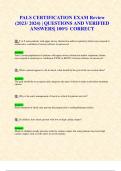
-
PALS CERTIFICATION EXAM Review (2023/ 2024) | QUESTIONS AND VERIFIED ANSWERS| 100% CORRECT
- Exam (elaborations) • 32 pages • 2023
-
Available in package deal
-
- $10.99
- + learn more
PALS CERTIFICATION EXAM Review (2023/ 2024) | QUESTIONS AND VERIFIED ANSWERS| 100% CORRECT Q: T or F some patients with upper airway obstruction and/or respiratory failure may respond to noninvasive ventilation if airway reflexes are preserved. Answer: True! Certain populations of patients with upper airway obstruction and/or respiratory failure may respond to noninvasive ventilation (CPAP or BiPAP) if airway reflexes are preserved. Q: When a patient appears to be in shock, wha...
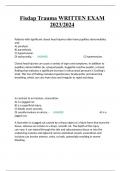
-
Fisdap Trauma WRITTEN EXAM 2023/2024
- Exam (elaborations) • 75 pages • 2023
-
- $10.99
- + learn more
Fisdap Trauma WRITTEN EXAM 2023/2024 Patients with significant closed head injuries often have pupillary abnormalities and: A) paralysis. B) paresthesia. C) hypertension. D) tachycardia. - ANSWER C) hypertension. Closed head injuries can cause a variety of signs and symptoms. In addition to pupillary abnormalities (ie, unequal pupils, sluggishly reactive pupils), a classic finding that indicates a significant increase in in...

That summary you just bought made someone very happy. Also get paid weekly? Sell your study resources on Stuvia! Discover all about earning on Stuvia


